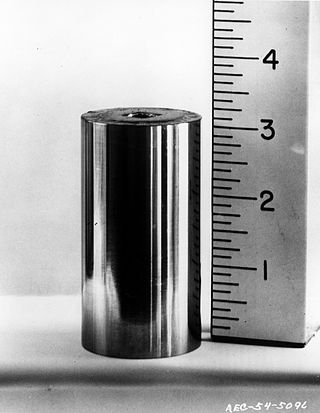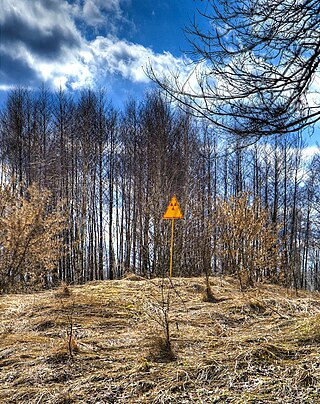
Radioactive waste is a type of hazardous waste that contains radioactive material. Radioactive waste is a result of many activities, including nuclear medicine, nuclear research, nuclear power generation, nuclear decommissioning, rare-earth mining, and nuclear weapons reprocessing. The storage and disposal of radioactive waste is regulated by government agencies in order to protect human health and the environment.
A dirty bomb or radiological dispersal device is a radiological weapon that combines radioactive material with conventional explosives. The purpose of the weapon is to contaminate the area around the dispersal agent/conventional explosion with radioactive material, serving primarily as an area denial device against civilians. It is not to be confused with a nuclear explosion, such as a fission bomb, which produces blast effects far in excess of what is achievable by the use of conventional explosives. Unlike the rain of radioactive material from a typical fission bomb, a dirty bomb's radiation can be dispersed only within a few hundred meters or a few miles of the explosion.

A nuclear and radiation accident is defined by the International Atomic Energy Agency (IAEA) as "an event that has led to significant consequences to people, the environment or the facility." Examples include lethal effects to individuals, large radioactivity release to the environment, or a reactor core melt. The prime example of a "major nuclear accident" is one in which a reactor core is damaged and significant amounts of radioactive isotopes are released, such as in the Chernobyl disaster in 1986 and Fukushima nuclear disaster in 2011.

Radioactive contamination, also called radiological pollution, is the deposition of, or presence of radioactive substances on surfaces or within solids, liquids, or gases, where their presence is unintended or undesirable.

The Goiânia accident was a radioactive contamination accident that occurred on September 13, 1987, in Goiânia, Goiás, Brazil, after an unsecured radiotherapy source was stolen from an abandoned hospital site in the city. It was subsequently handled by many people, resulting in four deaths. About 112,000 people were examined for radioactive contamination and 249 of them were found to have been contaminated.

The Mayak Production Association is one of the largest nuclear facilities in the Russian Federation, housing a reprocessing plant. The closest settlements are Ozyorsk to the northwest and Novogornyi to the south.

Cobalt-60 (60Co) is a synthetic radioactive isotope of cobalt with a half-life of 5.2714 years. It is produced artificially in nuclear reactors. Deliberate industrial production depends on neutron activation of bulk samples of the monoisotopic and mononuclidic cobalt isotope 59
Co
. Measurable quantities are also produced as a by-product of typical nuclear power plant operation and may be detected externally when leaks occur. In the latter case the incidentally produced 60
Co
is largely the result of multiple stages of neutron activation of iron isotopes in the reactor's steel structures via the creation of its 59
Co
precursor. The simplest case of the latter would result from the activation of 58
Fe
. 60
Co
undergoes beta decay to the stable isotope nickel-60. The activated cobalt nucleus emits two gamma rays with energies of 1.17 and 1.33 MeV, hence the overall equation of the nuclear reaction is: 59
27Co
+ n → 60
27Co
→ 60
28Ni
+ e− + 2 γ

Caesium-137, cesium-137 (US), or radiocaesium, is a radioactive isotope of caesium that is formed as one of the more common fission products by the nuclear fission of uranium-235 and other fissionable isotopes in nuclear reactors and nuclear weapons. Trace quantities also originate from spontaneous fission of uranium-238. It is among the most problematic of the short-to-medium-lifetime fission products. Caesium-137 has a relatively low boiling point of 671 °C (1,240 °F) and easily becomes volatile when released suddenly at high temperature, as in the case of the Chernobyl nuclear accident and with atomic explosions, and can travel very long distances in the air. After being deposited onto the soil as radioactive fallout, it moves and spreads easily in the environment because of the high water solubility of caesium's most common chemical compounds, which are salts. Caesium-137 was discovered by Glenn T. Seaborg and Margaret Melhase.

Lake Karachay, sometimes spelled Karachai or Karachaj, was a small lake in the southern Ural Mountains in central Russia. Starting in 1951, the Soviet Union used Karachay as a dumping site for radioactive waste from Mayak, the nearby nuclear waste storage and reprocessing facility, located near the town of Ozyorsk. Today the lake is completely infilled, acting as "a near-surface permanent and dry nuclear waste storage facility."

Strontium-90 is a radioactive isotope of strontium produced by nuclear fission, with a half-life of 28.8 years. It undergoes β− decay into yttrium-90, with a decay energy of 0.546 MeV. Strontium-90 has applications in medicine and industry and is an isotope of concern in fallout from nuclear weapons, nuclear weapons testing, and nuclear accidents.
Radioactive scrap metal is created when radioactive material enters the metal recycling process and contaminates scrap metal.

This is a list of criminal acts intentionally involving radioactive substances. Inclusion in this list does not necessarily imply that anyone involved was guilty of a crime. For accidents or crimes that involved radioactive substances unbeknownst to those involved, see the Nuclear and radiation accidents and incidents.

The Red Forest is the ten-square-kilometre (4 sq mi) area surrounding the Chernobyl Nuclear Power Plant within the Exclusion Zone, located in Polesia. The name "Red Forest" comes from the ginger-brown colour of the pine trees after they died following the absorption of high levels of ionizing radiation as a consequence of the Chernobyl nuclear disaster on 26 April 1986. The site remains one of the most contaminated areas in the world today.
Naturally occurring radioactive materials (NORM) and technologically enhanced naturally occurring radioactive materials (TENORM) consist of materials, usually industrial wastes or by-products enriched with radioactive elements found in the environment, such as uranium, thorium and potassium and any of their decay products, such as radium and radon. Produced water discharges and spills are a good example of entering NORMs into the surrounding environment.
The Acerinox accident was a radioactive contamination accident in the province of Cádiz. In May 1998, a caesium-137 source managed to pass through the monitoring equipment in an Acerinox scrap metal reprocessing plant in Los Barrios, Spain. When melted, the caesium-137 caused the release of a radioactive cloud. The Acerinox chimney detectors failed to detect it, but it was eventually detected in France, Italy, Switzerland, Germany, and Austria. The activity concentrations measured were up to 1000 times higher than normal background levels, although the absolute values recorded are still regarded as negligible in terms of radiation protection.

The radiation effects from the Fukushima Daiichi nuclear disaster are the observed and predicted effects as a result of the release of radioactive isotopes from the Fukushima Daiichii Nuclear Power Plant following the 2011 Tōhoku 9.0 magnitude earthquake and tsunami. The release of radioactive isotopes from reactor containment vessels was a result of venting in order to reduce gaseous pressure, and the discharge of coolant water into the sea. This resulted in Japanese authorities implementing a 30-km exclusion zone around the power plant and the continued displacement of approximately 156,000 people as of early 2013. The number of evacuees has declined to 49,492 as of March 2018. Radioactive particles from the incident, including iodine-131 and caesium-134/137, have since been detected at atmospheric radionuclide sampling stations around the world, including in California and the Pacific Ocean.

The Elephant's Foot is the nickname given to the large mass of corium, composed of materials formed from molten concrete, sand, steel, uranium, and zirconium. The mass formed beneath Reactor 4 of the Chernobyl Nuclear Power Plant, near Pripyat, Ukraine, during the Chernobyl disaster of 26 April 1986, and is noted for its extreme radioactivity. It is named for its wrinkled appearance and large size, evocative of the foot of an elephant.

Kambalda Nickel Operations or Kambalda Nickel Mine is a surface and underground nickel mine as well as a nickel concentrator, near Kambalda East, Western Australia. The deposit was discovered in 1954 and the mine opened in 1967, operated by WMC Resources which was taken over by BHP in 2005. Prior to this, between 2001 and 2003, WMC ceased mining operations at Kambalda and divested itself of the mining assets.













